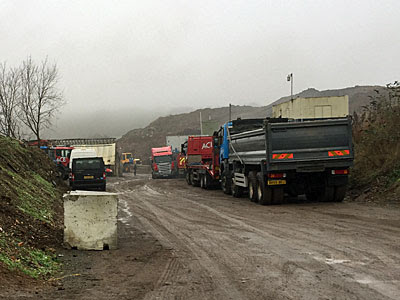Some Greens are worried about how HS2& #39;s drilling and tunnelling into the chalk below its route might affect drinking water and chalk streams such as the River Misbourne. It& #39;s a challenge, but they needn& #39;t be too alarmed. A thread on piles and tunnels ... /1
We& #39;ll start with a disclaimer - we& #39;re not water or geology experts, so we& #39;re open to correction if anything we say here turns out to be wrong. /2
First up - piling in the Colne Valley. To hold up the viaduct where the railway crosses the valley, HS2 has to drive piles through the upper soils down into the chalk which lies below. (This is what the viaduct will look like when it& #39;s done). /3
The chalk is porous rock and is an aquifer from which quite a lot of London& #39;s drinking water is drawn. The Colne Valley, for all that it looks tranquil enough now, has a busy industrial past behind it. Along the way a lot of unpleasant muck got dumped... /4
.. particularly at Newyears Green, a waste facility. Here it is. (thanks @diamondgeezer for the pic). It& #39;s contaminated land ( https://archive.hillingdon.gov.uk/article/8677/Contaminated-land-public-register).">https://archive.hillingdon.gov.uk/article/8... There& #39;s a rather murky stream, the Newyears Green Bourne, which runs by here and down into the River Colne. /5
The worry is that contaminated water or topsoil could go down a piling hole, end up in the aquifer and leach into the drinking water. It& #39;s a legitimate concern and one that needs to be taken seriously. That said, dealing with it is nothing special. /6
Any building or viaduct ever built on a brownfield site in or around London has had the same issue. Engineers sink piles through the soil and into the chalk all the time. There are rules: here& #39;s the Environment Agency note: https://webarchive.nationalarchives.gov.uk/20140329082414/http://cdn.environment-agency.gov.uk/scho0202bisw-e-e.pdf">https://webarchive.nationalarchives.gov.uk/201403290... /7
We& #39;re talking about "Pollution Scenario 1" from that document here. To stop water getting in to the pile holes they drive in a metal casing then fill the hole up with bentonite clay slurry to keep it under pressure. /8
Then, once the concrete of the pile has set, no water can get down. So standard stuff, but of course they need to be skilled and do the job properly. We should make sure they do. (Here& #39;s how it works: https://www.youtube.com/watch?v=0-O-Vt8DSZM)">https://www.youtube.com/watch... /9
Next - tunnelling through the chalk - which HS2 have to do under the Chilterns. Here, the concern is that the River Misbourne, that the tunnel passes quite close beneath, will be disturbed. The chalk there has a lot of fissures in it so the water could leak away. /10
The first thing to point out is that tunnelling through chalk is commonplace: the Channel Tunnel is all in chalk. The Jubilee Line extension, Crossrail, Thames Tideway and DLR all go through chalk. The techniques for doing it are well known. /11
Tunnellers always have to deal with water and cracked rock and other geological challenges while working. They understand how to do it. HS2& #39;s problem is how to make sure water doesn& #39;t leak into the tunnel through fissures in the chalk. /12
They do it by pressurising the ground as the tunnel is being dug, using a Mix Shield Tunnel Boring Machine. The pressure inside the TBM balances the water pressure in the ground. (Here& #39;s a little video showing how it works: https://www.youtube.com/watch?v=fSwbzvtXON8).">https://www.youtube.com/watch... /13
So there& #39;s a concern, and HS2 are right to be watched carefully and put on the spot. And all the right safeguards and risk assessments need to be done. But there& #39;s no cause for alarm and no excuse for alarmism. /14
We think @HS2ltd should be open and up-front about all the engineering they& #39;re doing on the tunnel and how much they understand about the problems they have to deal with. We don& #39;t think these challenges are a reason for Greens to oppose the whole scheme. /15
Oh - a postscript. Much has been made by some high-profile objectors of the amount of water that the tunnelling process will need - up to 10 MEEELION LITRES a day! That sounds like an awful lot - but wait! That& #39;s 10000 cubic metres a day .. /16
Or just under 7 cubic metres a minute. The River Colne discharges about 4 cu m per second ( https://en.wikipedia.org/wiki/River_Colne,_Hertfordshire)">https://en.wikipedia.org/wiki/Rive... - so HS2 will be taking less than 1/30 of the river& #39;s flow - and that& #39;s after all the drinking water has been extracted. /17
And by way of context, Affinity Water loses over 20% of the water in its pipes: that& #39;s 189 MEEELION LITRES a day - nearly 20 times what HS2 needs. https://www.affinitywater.co.uk/docs/Affinity_Water_Final_WRMP19_April_2020.pdf,">https://www.affinitywater.co.uk/docs/Affi... page 7). So yes, HS2 tunnelling uses a fair bit, but it& #39;s not a ridiculous amount. /end

 Read on Twitter
Read on Twitter



